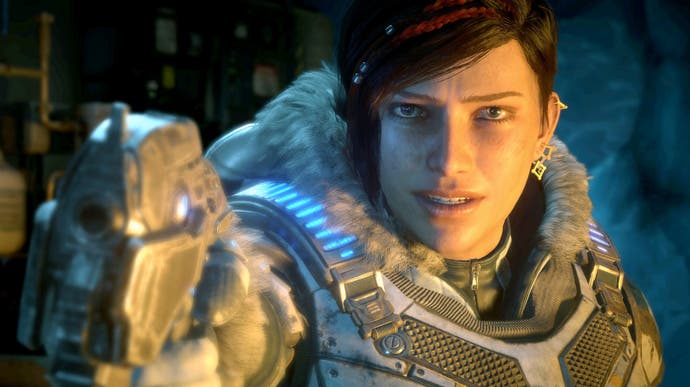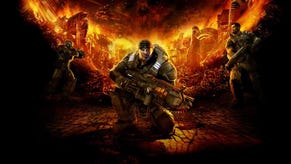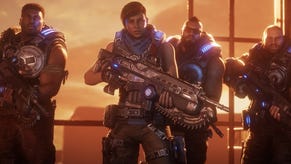Gears 5: the tech showcase that sets new standards for Xbox One
Unreal.
Gears of War 4 marked a turning point for Microsoft's classic franchise, with new studio The Coalition taking over franchise development duties. Its 2016 debut delivered a gorgeous but safe instalment in the series. Gears 5, by comparison, is a revelation in pretty much every regard. It's an ambitious new take on the series, pushing gameplay into uncharted territory while delivering perhaps the most advanced and performant Unreal Engine 4 title to date - and something of a technological high point for both Xbox One consoles.
Of course, Gears is a series that has always been synonymous with pushing technical boundaries - from the very first Xbox 360 release through its various sequels, each game has served as a showcase for Unreal Engine and the skilled developers working on each project. Gears 5, however, delivers one of the greatest leaps in fidelity the series has experienced to date, with a wide range of impressive new visual features on offer alongside some serious optimisation, with Xbox One X targeting a massively ambitious 60 frames per second. With that in mind, the sheer level of detail on display in each area is staggering - especially when you consider the frame-rate and resolution targets.
So let's begin with the basics, kicking off with image quality. In the case of Gears 5, the overall solution to rendering quality is a complex one, utilising a range of techniques that have become increasingly common this generation. Yes, dynamic resolution scaling is in effect on both console versions - albeit with a twist. As expected, X targets a native 4K at the upper bounds, while the base unit tops out at 1080p. That said, actual native rendering resolution is adjusting regularly during gameplay, producing results on X such as 1584p, 1728p, 2160p and the like. Xbox One S renders at quarter resolution by comparison - including values such as 792p and 864p up to full 1080p. The gap between S and X seems par for the course then, until you realise that the enhanced machine is essentially delivering twice the frame-rate.
However, native rendering resolution is just the start of the story. Gears 5 uses a temporal upscaling solution, increasing fidelity by drawing upon information from prior frames, so resolution values aren't quite as cut and dried as you may think. View geometry is adjusted on the fly based on GPU load using dynamic resolution - this is then upscaled to match the final output such as 4K in the case of Xbox One X. It's after this point that all post-processing such as motion blur, bloom, tone-mapping and the like is applied, not to mention the HUD. So, basically, geometry rendering varies in resolution but post-effects are always rendered at full resolution, giving an overall cleaner look.
Performance in campaign mode is generally sound on both systems - the S sticks very closely to a locked 30 frames per second and performs very closely to Gears 4, significantly improved over and any all Gears outings on Xbox 360. The X is something of a revelation, however. Overall, the game runs beautifully smoothly at 60 frames per second and with only mild dips to the mid-50s accompanied by a touch of screen-tearing at the top portion of the screen when the game is really under load (perhaps an id-style 'aggressive' dynamic scaling option might help here?).
Even split-screen mode works out rather well, and again there's the sense that the Coalition has gone above and beyond the call of duty in supporting local multiplayer. Both two-player and three-player split-screen options are implemented on both S and X consoles. On the enhanced machine, the frame-rate cap drops to 30, but the action holds up pretty well regardless. The same feature is available on S consoles -but there's no such thing as a free launch in game rendering terms, and performance here can be somewhat variable. Beyond resolution and frame-rate differences, what strikes me as remarkable is how close Gears 5 looks between S and X consoles otherwise. When you look at a first-party console release, you expect a showcase event that pushes your hardware further than it's been taken before - and in this regard, there's no doubt that Gears 5 delivers here.
Loading up the campaign from scratch, the visual standard is initially set by the character rendering. Following its pre-rendered introductory credits sequence, the game drops into a gorgeous series of cutscenes and unlike Gears 4, every story-driven cinematic is rendered entirely in real-time. This is especially impressive during complex sequences where the camera quickly cuts between varying shots, with no visible texture pop-in - even while impressively detailed destruction is unleashed.
Naturally, the cast take centre-stage here and this is where we see our first major improvement over Gears 4. Each character has received a circa-50 per cent increase in overall polygon count - edges are now smoother with few visible edges present in any scene. In building the characters, artists reworked facial features and details to more accurately simulate the appearance of light playing off and shining through skin. The specularity of skin simulates the play of light off and through its surface and Gears 5 now support dual lobe specularity. By using dual specular roughness values, The Coalition creates a more natural skin effect, with a sheen that accurately replicates how light interacts with skin oil.
The eye shader is also improved with proper light scattering below the surface, dynamic iris caustics and more. The objective is to create a more realistic representation of the eye, which is a key component of natural character rendering. In addition to facial features, a lot of attention is poured into armour and clothing. Materials are now more natural and unified on the back-end, allowing the artists to build clothing which more closely simulates metal, leather and cloth.
Animation is also hugely improved over Gears 4 and taken together, the cinematic character rendering is among the best in the industry right now, standing tall alongside the likes of Naughty Dog's efforts. All of this impressive stuff is, of course, combined with other high-quality effects work. Unreal Engine 4's motion blur is top-class, producing a clean, artefact-free velocity blur that looks remarkably realistic during real-time cutscenes - and it's key to achieving a pseudo pre-rendered look. In addition, an updated depth of field effect is used during cinematics that delivers an even higher level of quality than Gears of War 4 PC's insane quality depth of field preset. This time, we get high-quality, performant bokeh depth of field across all platforms - and it too looks fantastic.
But it's the environments that really steal the show. Gears is a series that has always focused on delivering a high level of micro-detail, with richly detailed structures and objects populating each scene. There's a focus on 'destroyed beauty' that evolves in Gears 5, with The Coalition's art team handing in some colourful and vibrant worlds. It's a sequel that ditches the series' bleak colour palette in favour of vibrant blues, greens and reds, depending on the scene. This is all best experienced in HDR, where Gears 5 takes the crown as perhaps the best implementation of high dynamic range rendering I've experienced to date - to my eyes, it's easily in the same class as the phenomenal Gran Turismo Sport. The game looks decidedly different and, to my eye, superior when playing in HDR. To achieve this, machine learning was utilised to train an inverse tone-mapper for colour-space conversion, based on a large set of HDR and SDR images from other first-party Xbox games.
The start of Gears 5 sees the game lay out its stall in spectacular style, beginning on a ruined island packed with snarling branches and dilapidated facilities stretching off into the distance. The very first scene drops you in a pool of water - light pierces the surface, dancing across the bottom of a crystal-clear pool, with screen-space reflections allowing the surrounding environment to reflect across its surface. Detailed ruins and foliage encircle this pool of water, blowing gently in the breeze. Volumetric lighting is beautifully deployed throughout the game; atmospheric rendering giving the impression of density within the air. It's a feature used throughout, from beams of light piercing a dark cavern and low-hanging fog visible in the distance, to the dust and debris lit by the low-hanging sun - with a volumetric fog system contributing greatly to the atmosphere.
The second area in the game moves into more familiar territory for the Gears series with detailed urban landscapes and building interiors. The level of detail on display is impressive - with even incidental detail right down to individual snack packets rendered at an impressively high resolution. Certain textures also receive extra depth thanks to cone-step mapping. The idea here is to simulate how light interacts with a material surface in three dimensions, giving the illusion of additional geometric surface detail by shading chunks based on depth and surface normal information placed on the mesh. The results appear similar to parallax occlusion mapping but the quality is improved and performance is higher.
The third biome in Gears 5 is based on ice - an area that offers both new rendering features and gameplay concepts. One key feature is deformation, allowing characters, objects and vehicles to leave persistent, accurate trails in their wake. A tessellation shader is run on local deformation allowing the paths to appear smooth and artefact-free, while a normal map is generated dynamically from this data, allowing the deformation to remain visible even at a distance. The same technique is also used in the desert stage, with tracks from your skiff even stretching back into the distance.
Environmental interactions have clearly had a lot of thought put into them, and that extends to destruction. A new system the team calls Swift Destruction allows pre-fractured mesh objects to be destroyed using a vertex shader - this is likely how the game's destructible cover functions. Beyond this, however, there is another impressive gameplay feature in Gears 5: breakable ice. In certain areas, frozen ponds can be used to your advantage - shoot the ice and it breaks, spelling doom to any enemies standing on it. It's a small feature, but Gears is packed with new, smart technology from GPU-accelerated particles that use vertex shaders (reducing CPU impact to zero) to fully dynamic, across-the-board real-time shadows. The typical cascaded shadows maps are in place but where things get interesting is how the game handles distant shadows, with ray tracing-derived distance fields delivering more natural, more accurate soft shadows, visible across more objects at a distance.
I'd urge you to sit back and watch the video I put together for this game - I hope it emphasises what an epic technical achievement this is. But there's more to Gears 5 than technology alone and as a fan of the series, I wanted to share some thoughts about the game itself. Suffice to say, The Coalition has not left me disappointed. Yes, the core Gears gameplay is still very much in place, but there are new elements which really change things for me.
To begin with, let's discuss encounters - in a typical Gears game, you roll up to a new location, the Locust spawn and you fight them until they're gone. Crucially, it's the enemy that always initiates combat. However, Gears 5 features a number of encounters that more closely resemble an experience like Halo, where the enemies are already present in the environment - usually on patrol as you arrive. This change doesn't have a huge impact on the overall gameplay but it allows you to use a limited stealth system to get a leg up on the enemy before taking them on more directly and it alters the overall mood and atmosphere in a very positive way.
Secondly, there's the open world and this too reminds me of Halo, especially with the vehicles involved. It deviates from the linearity seen in prior Gears titles and adds some degree of variety to the action. It also helps to flesh out the world, while allowing the player to have fun with the driving mechanics. Crucially, this isn't trying to be an open world with busy work and fetch quests - but rather, it's a chance for the game to stretch its legs. The skiff is a blast to pilot, much like the Warthog reminded me almost of a simplified take on SSX. It really lends the game a different style of pacing, with longer quiet areas between the combat zones.
These changes - combined with the exciting scenery and interesting encounters - make for a Gears game that feels familiar yet fresh and I greatly enjoyed playing through it. The bottom line is that Gears 5 is not only excellent fun, but it's also one of the best-looking games on Xbox One. It runs like a dream while evolving the series in interesting new ways. It may not be quite perfect but for those looking for a brilliant triple-A gaming blockbuster, I can't recommend it highly enough. And these impressions all come from the single-player campaign - there's still horde mode and multiplayer to dip into as well. And on top of all of that, the PC version is looking extremely impressive too. We'll be reporting back on that release in the very near future.












